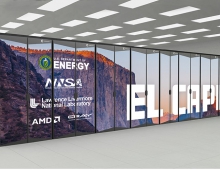
World's Fastest U.S. Summit Supercomputer Uses IBM and Nvidia chips
The U.S. has regained the "crown" of the world's fastest supercomputer. The Summit computer, which will be used for the U.S. Department of Energy's Oak Ridge National Laboratory, uses IBM and Nvidia technology and is twice as fast as the current record holder in China.
The system cost about $200 million to build, will occupy a warehouse the size of two tennis courts and be put to work on super-complex calculations that could lead to breakthroughs in fields from astrophysics to cancer research, the lab said Friday.
The system will be housed at the Oak Ridge National Laboratory has been dsigned on a new heterogeneous architecture and combines IBM POWE9 CPUs with Nvidia GPUs. It has approximately 4,600 nodes, wit six Nvidia Volta Tensor Core GPUs per node -- that's more that 27,000.

Summit operates at a speed of 200,000 trillion calculations per second -- or 200 petaflops. That's more than twice as fast as the current record holder, the Sunway TaihuLight at the National Super Computer Center in Guangzhou, China, which runs at 93 petaflops. The third-fastest machine is also in China, operating at 33.8 petaflops.
IBM and Nvidia says that the supercomputer is much faster, while only needing 30 percent more power than previous systems. Still, Summit needs the same amount of power it takes to serve a small town.
The supercomputer consists of 4,608 compute nodes, containing a total of 9,216 IBM Power 9 processors and 27,648 Nvidia Tesla V100 GPU modules. The Power 9 and V100 chips communicate over NVLink, a high speed, high bandwidth mesh interconnect. Summit?s full fat-tree network is built using InfiniBand EDR switch cards from Mellanox.
The supercomputer is the first public high-performance cluster to support PCIe 4.0 at a scale of thousands of nodes.
Summit is comprised of 256 59kW racks of compute nodes and 40 38kW racks of IBM Spectrum Scale storage. Each rack includes two top of rack switches. Eighteen racks of core switches implement the fat-tree network between compute and storage racks. Overall, the massive system claims a 2.5 terabit/second cross-sectional network bandwidth.
The computer will use artificial intelligence techniques like machine learning. Summit will speed up projects that require modeling massive events with trillions of possible outcomes, like the physics of supernova implosions, or how climate change is affecting weather patterns.
The machine will also work on simulating new materials for superconductors that will allow computers to run more efficiently and at lower temperatures, as well as looking at mitochondria in cells to develop early-warning tests for genetic diseases like Parkinson's and Alzheimer's.
The Department of Energy officially controls the system and who gets to use it.




















